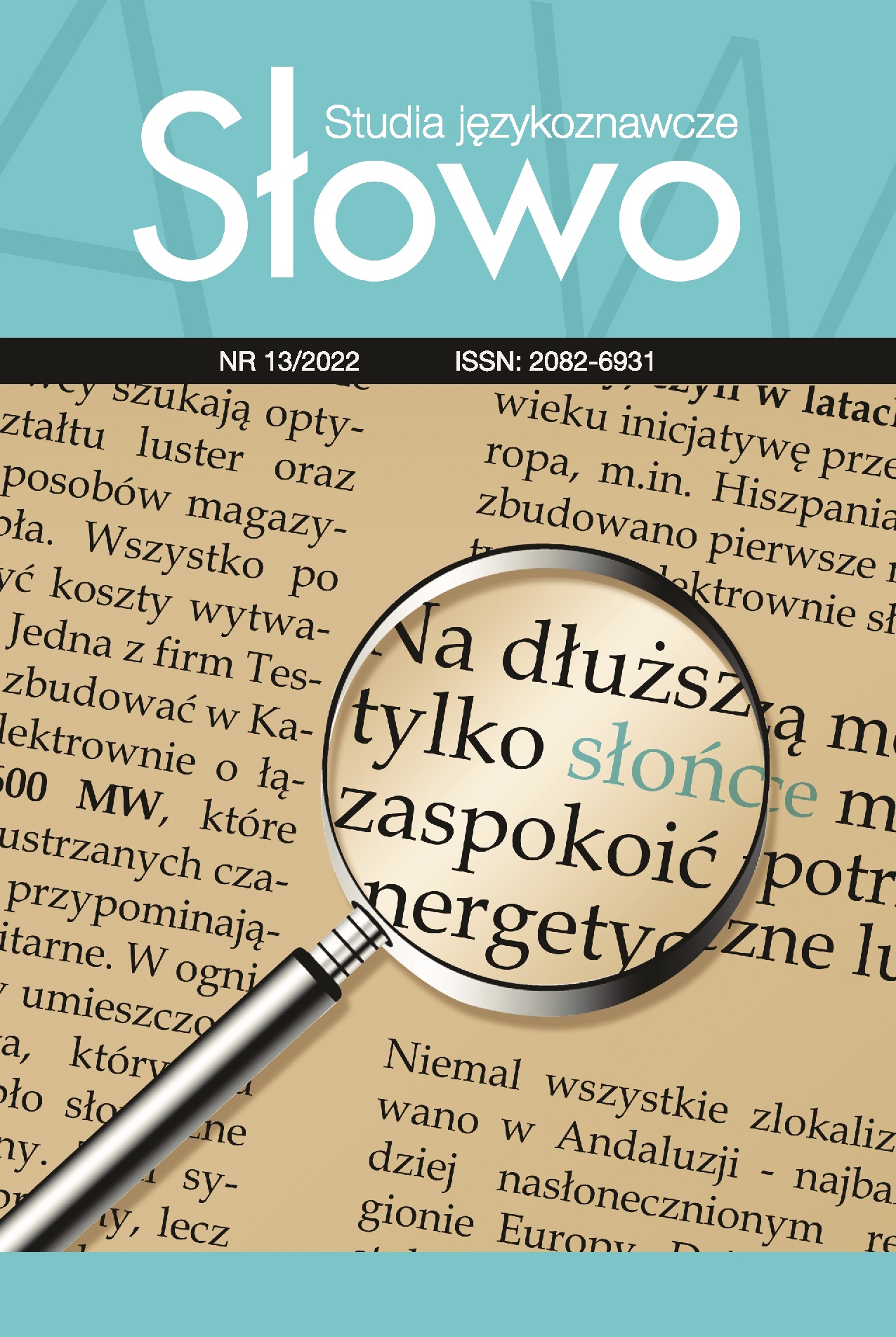W polu widzenia: morfem i grafem 見 jiàn ‘widzieć’ we współczesnym języku chińskim
DOI:
https://doi.org/10.15584/slowo.2022.13.33Słowa kluczowe:
pismo chińskie, znaki chińskie, klucze semantyczne, pole semantyczne ‘widzenie’, klucz 見 jiànAbstrakt
Artykuł poświęcony jest omówieniu chińskiego monosylabicznego wyrazu i klucza semantycznego 見 jiàn ‘widzieć’ z perspektywy morfologicznej i grafemicznej. Wprowadzenie do tematu zawiera zarys relacji morfemu, sylaby i grafemu w języku chińskim. Dalej przywołany jest umotywowany historycznie kanon grafemów stanowiących indeks do organizacji haseł w słowniku chińskim i podstawowe reguły zapisu znaków pisma chińskiego. W artykule omówiony został grafem 見 jiàn jako jeden z 214 kluczy Kangxi, które mogą być samodzielnym znakiem pisma lub / i komponentem znaków. Aby zaproponować model zależności znaczeń morfemów przyporządkowanych do tego klucza, analizie poddano związek ich prototypowego (najbardziej wyrazistego) znaczenia z komponentem semantycznym 見 jiàn. Analiza konotacji grafemu 見 jiàn w roli klucza semantycznego w tradycyjnym zapisie morfemów w polu semantycznym ‘widzenie’ wykazała różny stopień przejrzystości semantycznej komponentu graficznego w zapisanych morfemach.
Downloads
Bibliografia
Cao, N.M. 曹乃木 (1993). 部首查字法的历史演进Bùshǒu cházìfǎ de lìshǐ yǎnjìn. 语文建设 Yǔwén jiànshè, 2, 29–32.
DeFrancis, J. (1989). Visible Speech: The diverse oneness of writing systems. Honolulu: University of Hawaii Press.
Harbaugh, R. (1999). Chinese Characters: A Genealogy and Dictionary. New Haven: Yale University Press (także: http://www.zhongwen.com/about.htm [dostęp: 30.10.2022]).
Huang, P.R. 黃沛榮 (2009). 漢字教學的理論與實踐 Hànzì jiàoxué de lǐlùn yǔ shíjiàn. Tajpej: 樂 學書局 Yuè xué shūjú.
Künstler, M.J. (1970). Pismo chińskie. Warszawa: Wydawnictwo Akademickie Dialog.
Künstler, M.J. (2000). Języki chińskie. Warszawa: Wydawnictwo Akademickie Dialog.
Su, P.C. 苏培成 (2001). 现代汉字学纲要Xiàndài hànzìxué gāngyào. Pekin: 北京大学出版社 Běijīng dàxué chūbǎn shè.
Wasilewska, H. (2019). Adaptacje i metamorfozy – znaki chińskie w wybranych sinograficznych systemach pisma Azji Wschodniej. Poznań: Poznańskie Towarzystwo Przyjaciół Nauk.
Wieger, L. (1927). Chinese characters. Their Origin, Etymology, History, Classification and Signification. (Przekład L. Davrout 1965). Nowy Jork: Paragon Book Reprint Corp. and Dover Publications Inc. https://www.academia.edu/33754790/WIEGER [dostęp: 30.10.2022].
Wilder, G.D. & J.H. Ingram (1972). Analysis of Chinese Characters. Tajpej: Ch’eng Wen Publishing Company.
Zajdler, E. (2008). Pismo chińskie i klucze semantyczne jako nośnik znaczenia leksykalnego. W: N. Pawlak (red.), Języki Azji i Afryki w komunikacji międzykulturowej (s. 113–124). Warszawa: Wydawnictwo Uniwersytetu Warszawskiego.
Zajdler, E. (2012). Graficzna reprezentacja świata w piśmie chińskim. W: H. Kardela, Z. Muszyński, M. Rajewski (red.), Główne pojęcia kognitywistyki: empatia, obrazowanie, kontekst (s. 223–237). Lublin: Wydawnictwo UMCS.
Zhang, D. 張鼎 (1985). 每日一字 Měi rì yī zì. Tajpej: 華視出版社 Huá shì chūbǎn shè.
Zuo, M.A. i Wang, J.Z. 左民安, 王尽忠 (1998). Hànzì bù shǒu jiǎngjiě. Fuzhou: 福建人民出版社 Fújiàn rénmín chūbǎn shè.
中國語教育研究所 Zhōngguó yǔ jiàoyù yánjiū suǒ, (1990). 最新實用中國語英語辭典Zuìxīn shíyòng zhōngguó yǔ yīngyǔ cídiǎn (ang. A New Practical Chinese-English Dictionary). 三文堂Sānwèn tang.
Ошанин И.М. (red.). (1983). Болшой Китайско-Русский Словарь. Moskwa: Издательство «Наука».
Słownik chiński online: https://www.zdic.net [dostęp: 30.10.2022].
Pobrania
Opublikowane
Jak cytować
Numer
Dział
Licencja
Prawa autorskie (c) 2022 Słowo. Studia językoznawcze

Utwór dostępny jest na licencji Creative Commons Uznanie autorstwa – Użycie niekomercyjne 4.0 Międzynarodowe.


